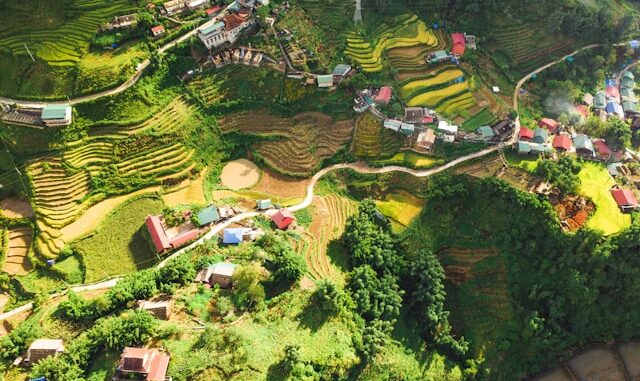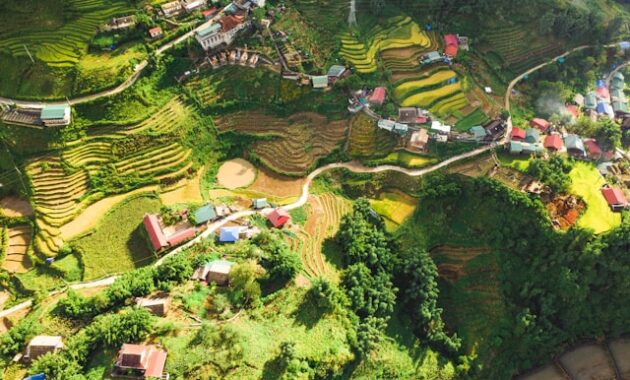
The rice terraces of Sa Pa are an iconic landmark in Vietnam, offering a stunning view of lush landscapes carved by generations of local farmers. Situated in the northern highlands of Vietnam, Sa Pa is a haven for travelers seeking an authentic and breathtaking experience. This article dives into the charm and allure of the Sa Pa rice terraces, exploring why they are a must-see destination for anyone visiting Vietnam. From the history and cultural significance to practical travel tips, this guide will help you plan an unforgettable journey to Sa Pa.
The Natural Beauty of Sa Pa Rice Terraces
Sa Pa is renowned for its lush green rice terraces, which stretch across the rolling hillsides of the region. These terraces, carved into the mountains, create an intricate network of fields that have been shaped by generations of local ethnic minority groups, including the H’mong, Tay, and Dao peoples. The view of these fields is nothing short of mesmerizing, with layers of vibrant green, golden hues during harvest season, and dramatic views over the mist-covered valleys.
The rice terraces are often seen as a living testament to the ingenuity and resilience of the locals who have worked the land for centuries. As you travel through Sa Pa, the sight of the staggering mountain slopes dotted with rice fields offers a visual feast for nature lovers and photographers alike. Whether you visit during the early stages of planting or the harvest season, each time of year offers a unique perspective of the terraces’ beauty.
Best Time to Visit Sa Pa Rice Terraces
The best time to visit the rice terraces of Sa Pa depends largely on the kind of experience you’re hoping to have. For those looking to see the terraces at their most vibrant and lush, the months of May through August are ideal. This is when the rice fields are full of water, reflecting the sky like giant mirrors, and the terraces glow in shades of green.
If you want to witness the breathtaking golden hues of the rice harvest, September to October is the perfect time to visit. During this period, the fields turn yellow as the rice ripens, offering a stunning contrast against the backdrop of the surrounding mountains. For those seeking a quieter experience, the winter months (November to February) are less crowded, though the terraces will not be as lush, and the weather can be chilly.
Cultural Significance of the Sa Pa Rice Terraces
The rice terraces of Sa Pa are not just a feast for the eyes; they also hold immense cultural and historical importance. For centuries, the terraces have been the lifeblood of the local ethnic minority communities, providing a source of livelihood and a reflection of their cultural heritage. The intricate design of the terraces speaks to the ingenuity of the people who have managed to transform the mountainous terrain into productive land for rice cultivation.
The indigenous people of Sa Pa, primarily the H’mong, Tay, and Dao, have developed sophisticated farming techniques to adapt to the steep landscape. These terraces, carefully built and maintained, represent a harmonious relationship between humans and nature, where sustainability and tradition are passed down from generation to generation. Visitors to the region can gain insight into the traditional farming practices, as well as the way of life that revolves around the rhythms of rice cultivation.

Trekking Through the Rice Terraces
One of the best ways to experience the rice terraces of Sa Pa is on foot. There are numerous trekking routes that wind through the terraces, offering an immersive experience where you can take in the breathtaking views, observe traditional farming practices, and interact with the local communities. Trekking is an excellent way to gain a deeper appreciation for the effort and skill involved in farming on such challenging terrain.
There are several trekking routes in Sa Pa, catering to different levels of difficulty and time commitment. For beginners, short day treks that explore the nearby villages and rice fields can be a great way to start. For more experienced trekkers, multi-day treks that take you deep into the mountain valleys and remote villages offer a more challenging and rewarding experience.
As you trek through the rice terraces, you’ll pass through picturesque villages such as Cat Cat, Ta Van, and Lao Chai, where you can interact with locals, purchase handmade crafts, and learn about the traditional ways of life. The trek can also offer an opportunity to experience the diverse cultures of Sa Pa’s ethnic minorities, as each community has its own unique customs, clothing, and language.
Sa Pa’s Diverse Ethnic Communities
One of the defining features of Sa Pa is its ethnically diverse population, with several minority groups calling the region home. The H’mong, Tay, Dao, and Giay peoples each contribute to the cultural richness of the area. Their distinctive customs, clothing, and practices offer a fascinating insight into the ethnic diversity of Vietnam.
The local ethnic groups are deeply connected to the rice terraces, relying on them for their agricultural needs. For instance, the H’mong are known for their deep connection to the land, often dressing in vibrantly colored traditional costumes and using farming methods passed down through generations. The Tay are expert farmers, and their traditional wooden houses are often seen dotting the landscape of the rice terraces. These communities provide a warm welcome to visitors, offering a chance to learn about their lifestyle, customs, and beliefs.
When visiting Sa Pa, make sure to take the time to interact with the local people. You can experience traditional dances, music, and crafts in various villages. The opportunities to learn about these fascinating cultures are one of the highlights of any trip to Sa Pa.
Getting to Sa Pa and Travel Tips
Sa Pa is accessible by train, bus, or private car from Hanoi, the capital of Vietnam. The train journey to Lao Cai, the nearest city to Sa Pa, takes around 8 hours, and from there, it’s about an hour’s drive to the town of Sa Pa. The bus ride is slightly cheaper, but it can take a bit longer due to road conditions.
Once in Sa Pa, getting around is relatively easy, though be prepared for steep and winding roads. Many visitors prefer to hire local guides for their trekking trips, as they provide valuable insights into the area’s history, culture, and natural beauty. Additionally, local homestays are a great option for those looking to immerse themselves in the local culture and enjoy a more authentic experience.
It’s important to note that the weather in Sa Pa can be unpredictable, with rain and mist common throughout the year. Be sure to pack accordingly, including sturdy trekking boots, a rain jacket, and plenty of water. While the region is becoming increasingly popular with tourists, it remains largely untouched by mass tourism, offering a peaceful retreat for those seeking tranquility and natural beauty.
Conclusion: Why You Should Visit Sa Pa
The rice terraces of Sa Pa are more than just a beautiful sight; they are a living testament to the resilience and ingenuity of the local communities. The combination of natural beauty, rich culture, and incredible trekking opportunities makes Sa Pa an unmissable destination for anyone traveling to Vietnam. Whether you’re a nature lover, culture enthusiast, or adventure seeker, Sa Pa’s stunning landscapes and welcoming communities will leave a lasting impression on you.